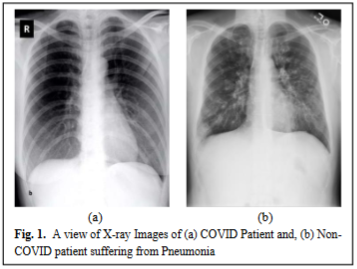A CNN Approach to Identify COVID-19 Patients among Patients with Pneumonia
Keywords:
CNN, COVID, Pneumonia, X-ray imagesAbstract
Due to COVID-19 pandemic, the healthcare system has been collapsed worldwide. Keeping in view of the shortage of healthcare services during these times, the automated identification of COVID patients among other non-COVID patients suffering from pneumonia is an essential task. It will help the medical professionals for speedy diagnosis of the patients with appropriate treatments. Therefore, the present work presents an automated approach for detection of COVID patients using convolutional neural network model. This approach takes into account chest X-ray images of COVID positive patients as well as non-COVID pneumonia patients for the training of the proposed CNN model. The simulation results show that the proposed CNN model performs binary classification of COVID and non-COVID pneumonia classes with an average accuracy of 97.92%, sensitivity of 99.69% and specificity of 98.48%. Thus, the proposed CNN model is an effective technique for the accurate identification of COVID patients among other patients suffering from bacterial or viral pneumonia using X-ray images.
Downloads
References
Wu F, Zhao S, Yu B, et al. “A new coronavirus associated with human respiratory disease in China”. Nature. vol. 579, issue 7798, pp. 265-269, 2020.
WHO, “Coronavirus disease (COVID-19)”, World Health Organization, November, 2021.
[Online]. Available: https://www.who.int/health-topics/coronavirus
Worldometer, “Coronavirus cases” Worldometer. November, 2021. [Online]. Available: https://www.worldometers.info/coronavirus
Lai CC, Shih TP, Ko WC, Tang HJ, Hsueh PR. “Severe acute respiratory syndrome coronavirus 2 (SARS-CoV-2) and coronavirus disease-2019 (COVID-19): The epidemic and the challenges,” International Journal of Antimicrobial Agents, vol. 55, no. 3, pp. 105924, 2020.
Yamamoto Y. “PCR in diagnosis of infection: Detection of bacteria in cerebrospinal fluids,” Clinical and Diagnostic Laboratory Immunology. vol. 9, no. 3, pp. 508-514, 2002.
Franquet T. “Imaging of pulmonary viral pneumonia,” Radiology. vol. 260, issue 1, pp. 18-39, 2011.
Pneumonia, Johns Hopkins Medicine, 2021. [Online]. Available: https://www.hopkinsmedicine.org/health/conditions-and-diseases/pneumonia
Cohen JP, Morrison P, Dao L, Roth K, Duong TQ, Ghassemi M. “COVID-19 Image Data Collection: Prospective Predictions Are the Future,” arXiv:2006.11988, 2020.
Wang X, Peng Y, Lu L, Lu Z, Bagheri M, Summers RM. “ChestX-Ray8: Hospital-Scale Chest X-Ray Database and Benchmarks on Weakly-Supervised Classification and Localization of Common Thorax Diseases,” National Library of Medicine, USA, 2020. [Online]. Available: https://uts.nlm.nih.gov/metathesaurus.html
Kuldeep Singh, Sukhjeet Singh and Jyoteesh Malhotra. “Spectral features based convolutional neural network for accurate and prompt identification of schizophrenic patients,” Proceedings of the Institution of Mechanical Engineers, Part H: Journal of Engineering in Medicine, vol. 235, issue 2, pp. 167-184, 2021.
Powers DMW, Ailab. “Evaluation: from precision, recall and f-measure to roc, informedness, markedness & correlation,” Journal of Machine Learning Technologies, vol. 2, pp. 37-63, 2011.
Baratloo A, Hosseini M, Negida A, el Ashal G. “Part 1: Simple Definition and Calculation of Accuracy, Sensitivity and Specificity,” Emergency, vol. 3, issue 2, pp. 48-49, 2015.
Lever J. “Classification evaluation: it is important to understand both what a classification metric expresses and what it hides,” Nature Methods, vol. 13, issue 8, pp. 603-605, 2016.
Mahmud T, Rahman MA, Fattah SA. “CovXNet: A multi-dilation convolutional neural network for automatic COVID-19 and other pneumonia detection from chest X-ray images with transferable multi-receptive feature optimization,” Computers in Biology and Medicine, vol. 122, pp. 103869, 2020.
Ozturk T, Talo M, Yildirim EA, Baloglu UB, Yildirim O, Rajendra Acharya U. “Automated detection of COVID-19 cases using deep neural networks with X-ray images,” Computers in Biology and Medicine, vol. 121, pp. 103792, 2020.
Rahimzadeh M, Attar A. “A modified deep convolutional neural network for detecting COVID-19 and pneumonia from chest X-ray images based on the concatenation of Xception and ResNet50V2,” Informatics in Medicine Unlocked, vol. 19, pp. 100360, 2020.
Vaid S, Kalantar R, Bhandari M. “Deep learning COVID-19 detection bias: accuracy through artificial intelligence” International Orthopaedics, vol. 44, issue 8, pp. 1539-1542, 2020.
Hemdan EE-D, Shouman MA, Karar ME. “COVIDX-Net: A Framework of Deep Learning Classifiers to Diagnose COVID-19 in X-Ray Images,” arXiv:2003.11055, 2020.

Downloads
Published
How to Cite
Issue
Section
License
Copyright (c) 2022 Kuldeep Singh, Jaspreet Kaur

This work is licensed under a Creative Commons Attribution-ShareAlike 4.0 International License.
All papers should be submitted electronically. All submitted manuscripts must be original work that is not under submission at another journal or under consideration for publication in another form, such as a monograph or chapter of a book. Authors of submitted papers are obligated not to submit their paper for publication elsewhere until an editorial decision is rendered on their submission. Further, authors of accepted papers are prohibited from publishing the results in other publications that appear before the paper is published in the Journal unless they receive approval for doing so from the Editor-In-Chief.
IJISAE open access articles are licensed under a Creative Commons Attribution-ShareAlike 4.0 International License. This license lets the audience to give appropriate credit, provide a link to the license, and indicate if changes were made and if they remix, transform, or build upon the material, they must distribute contributions under the same license as the original.





